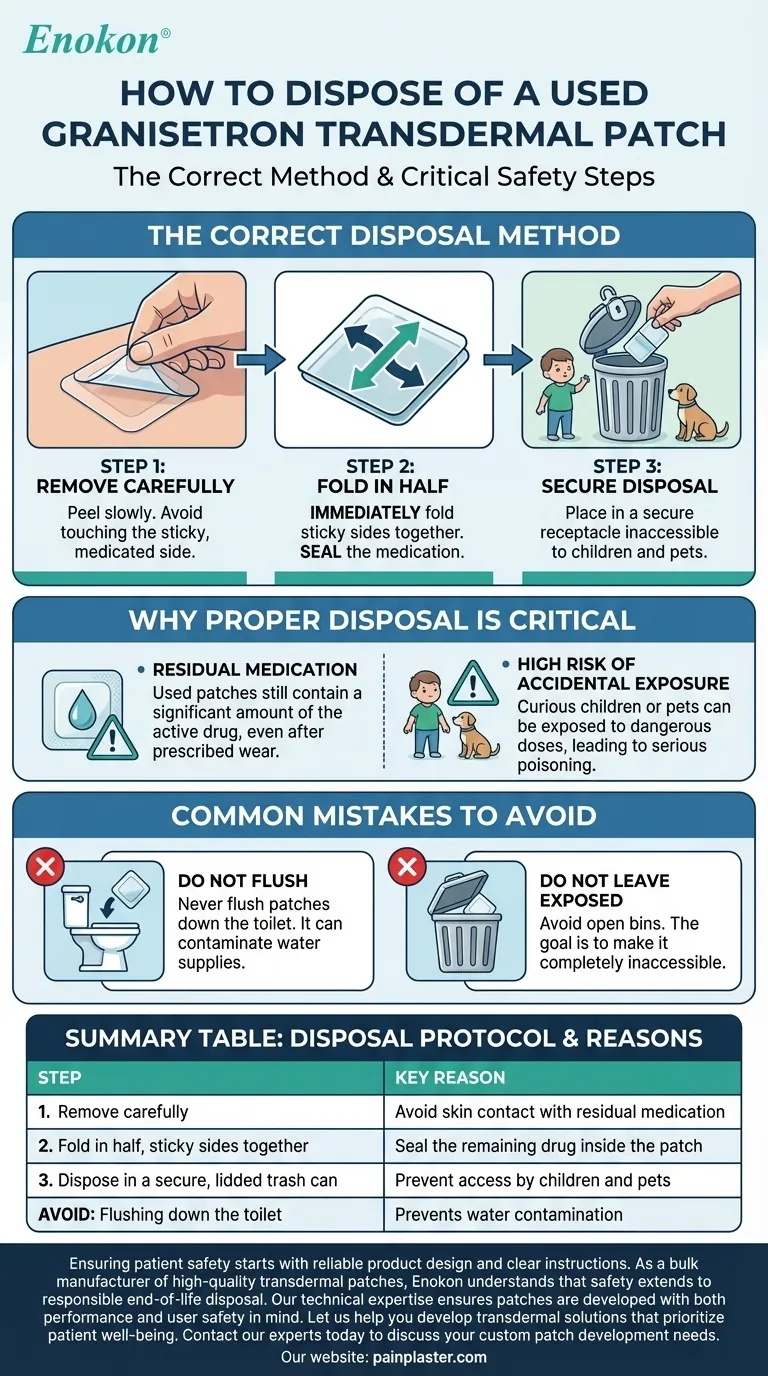The correct disposal method for a used granisetron transdermal patch is to carefully peel it off, fold it in half with the sticky sides together, and immediately throw it away in a trash receptacle that is safely out of reach of children and pets. This simple act prevents accidental exposure to the potent medication remaining in the patch.
Even after being worn for the prescribed time, a used patch contains a significant amount of its active drug. Proper disposal is not just a matter of cleanliness; it is a critical safety measure to protect others from unintended poisoning.

Why Proper Disposal is a Critical Safety Step
Transdermal patches are designed to hold more medication than is delivered during the intended wear time. This ensures a steady, consistent dose, but it also creates a potential hazard if the used patch is not handled correctly.
Residual Medication in Used Patches
A used granisetron patch is not empty. A substantial amount of the active ingredient remains embedded in the adhesive matrix even after it has been removed from your skin.
The High Risk of Accidental Exposure
If a child or pet finds a used patch, they can be exposed to a dangerous dose of medication. They might put it in their mouth, stick it on their skin, or chew on it, which can lead to serious poisoning.
The Standard Disposal Protocol
Following a precise method ensures that the remaining medication is sealed away and cannot harm anyone.
Step 1: Remove the Patch Carefully
When it is time to remove the patch, peel it off your skin slowly and carefully. Avoid touching the sticky, medicated side with your fingers if possible.
Step 2: Fold the Patch in Half
This is the most important step. Immediately fold the patch in half so that the sticky, adhesive sides press firmly together. This action effectively seals the remaining drug inside the patch.
Step 3: Place in a Secure Trash Receptacle
Dispose of the folded patch in a trash can that children and pets cannot access. A can with a secure lid is ideal. For maximum safety, you might consider placing it in a small bag before throwing it away.
Common Disposal Mistakes to Avoid
Incorrect disposal can neutralize your safety efforts and create unnecessary risks for your household or the environment.
Do Not Flush the Patch
Unless specifically instructed by a pharmacist for a particular medication, you should never flush transdermal patches down the toilet. The materials are not designed to break down in sewer systems and can introduce potent drugs into the water supply.
Do Not Leave Patches Exposed
Never leave a used patch on a nightstand, countertop, or in an open, easily accessible trash bin. The primary goal is to make it completely inaccessible to a curious child or pet from the moment it leaves your skin.
Making the Right Choice for Safety
Your specific situation may require slightly different levels of vigilance, but the core principle remains the same: seal and secure.
- If your primary focus is safety in a home with children or pets: Fold the patch and immediately place it in a trash can with a locking lid, or take the trash bag out of the house right away.
- If your primary focus is general best practice: The fold-and-secure-trash method is the universal standard that ensures you are handling the medication responsibly.
- If you are ever in doubt about any medication: Always consult the printed instructions that came with your prescription or speak directly with your pharmacist.
Responsible medication management is a key part of protecting yourself and those around you.
Summary Table:
| Step | Action | Key Reason |
|---|---|---|
| 1 | Remove patch carefully | Avoid skin contact with residual medication |
| 2 | Fold patch in half, sticky sides together | Seal the remaining drug inside the patch |
| 3 | Dispose in a secure, lidded trash can | Prevent access by children and pets |
| AVOID | Flushing down the toilet | Prevents water contamination |
Ensuring patient safety starts with reliable product design and clear instructions. As a bulk manufacturer of high-quality transdermal patches for healthcare and pharmaceutical brands, Enokon understands that safety extends beyond effective delivery to responsible end-of-life disposal. Our technical expertise in custom R&D ensures your patches are developed with both performance and user safety in mind.
Let us help you develop transdermal solutions that prioritize patient well-being at every stage. Contact our experts today to discuss your custom patch development needs.
Visual Guide

Related Products
- Far Infrared Heat Pain Relief Patches Transdermal Patches
- Herbal Eye Protection Patch Eye Patch
- Heating Pain Relief Patches for Menstrual Cramps
- Far Infrared Deep Heat Relief Patches Medicated Pain Relief Patches
- Capsaicin Chili Medicated Pain Relief Patches
People Also Ask
- How do Deep Heat Pain Relief Patches provide pain relief? Discover the Drug-Free Mechanism
- Can heat patches be used for fresh injuries? Avoid This Common Mistake for Faster Recovery
- What are the common side effects of using the medicated heat patch? Understanding Risks & Safe Use
- How quickly does the Deep Heat Pain Relief Back Patch activate and how long does it provide warmth? Get 16-Hour Relief
- What are the key features of the Deep Heat Pain Relief Back Patch? Get Up to 16 Hours of Drug-Free Relief













